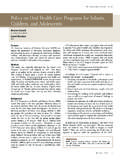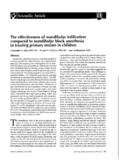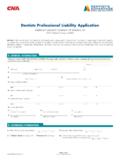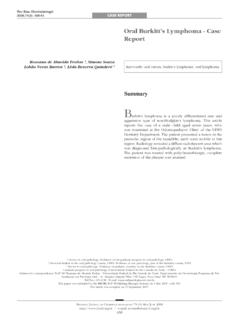Transcription of Partial pulpotomy for immature ... - Pediatric Dentistry
1 Review Article Partial pulpotomy for immature permanent teeth, its present and future Cheng D. Fong, BDS, MA, DDS Martin J. Davis, DDS. Dr. Fong is in private practice, Tenafly, NJ; Dr. Fong was assistant professor, Division of Endodontics, and Dr. Davis is associate dean for student and alumni affairs, professor and director, Division of Pediatric Dentistry , School of Dental and Oral Surgery, Columbia University, New York, NY. Correspond with Dr. Fong at Abstract Traumatic or carious exposure of a vital pulp in an immature permanent tooth presents a significant clinical challenge to maintain proper vitality.
2 Currently available procedures include direct pulp capping, complete pulpotomy and Partial pulpotomy . This paper reviews the application of Partial pulpotomy in immature permanent teeth and provides prognostic and technique guidance.(Pediatr Dent 24:29-32, 2002). KEYWORDS: Partial pulpotomy , ENDODONTICS. Received August 21, 2000 Revision Accepted November 26, 2001. I. n a mature permanent tooth with fully formed roots, an Although pulp capping and complete pulpotomy classi- exposed pulp should be completely removed, and the cally have been used most frequently, neither has given root canals should be obturated permanently.
3 However, satisfactory , 9-11 Several recent reports of the clini- definitive endodontic obturation in an immature tooth ar- cal application of Partial pulpotomy for teeth with cariously rests physiologic dentin deposition, resulting in a root with exposed pulps and for teeth with crown-fracture exposed a thin dentinal wall and predisposition to There- pulps have shown high success rates and satisfactory results, fore, whenever pulp exposure occurs in an immature tooth as indicated in Table The indications for and tech- with partially developed roots, it is appropriate to employ a niques of Partial pulpotomy are described hereafter.
4 Clinical technique which preserves as much vital pulp as pos- sible. This, in turn, enables continued physiologic dentin Indications for permanent tooth Partial deposition and complete root development. pulpotomy 1,5,9,14. There are three techniques available for treatment of 1. Tooth has no history of spontaneous pain. immature permanent teeth with exposed vital pulps: direct 2. Tooth has acute minor pain that subsides with analgesics. pulp capping, complete pulpotomy , and Partial pulpotomy . 3. Tooth has no discomfort to percussion, no vestibular Direct pulp capping, the placement of a wound dressing on swelling and no mobility.
5 An exposed pulp, is considered to be so unpredictable that 4. Radiographic examination shows normal appearance of several authors suggested that it to be removed from treat- periodontal attachment. ment 5. Pulp is exposed during caries removal or subsequent to Complete pulpotomy (also known as cervical pulpo- recent trauma. tomy) 6 is the removal of coronal pulp tissue and the 6. Tissue appears vital. placement of a wound dressing on the canal orifice. Com- 7. Bleeding from the pulp excision site stops with isotonic plete pulpotomy will arrest dentin formation in immature saline irrigation within 2 minutes.
6 Permanent teeth and can result in obliteration of the root ,8 It should be followed by complete endodontic Partial pulpotomy technique 1,5,9,14,20,21. therapy when root development is Partial Following local anesthesia, the teeth are isolated with a rub- pulpotomy (also known as pulp curettage),12-14 removal of ber dam. After smoothing sharp fracture edges or removing only the outer layer of damaged and hyperemic tissue in remaining carious dentin, the exposed pulp and surround- exposed pulps, is considered to be a procedure staged be- ing dentin are flushed clean with isotonic saline solution.
7 Tween pulp capping and complete ,10,12-14 The superficial layer of the exposed pulp and the surround- ing dentin are excised to a depth of about 2 mm using a Pediatric Dentistry 24:1, 2002 pulpotomy for permanent teeth Fong, Davis 29. high-speed diamond bur with light touch under waterspray the pulp chamber, unaffected healthy pulp tissue remains cooling. The surface of the remaining pulp is irrigated gen- in the deeper portion of the root canal system. Theoretically, tly with isotonic saline until bleeding has ceased.
8 After removal of the compromised/infected tissue should lead to hemostasis, a pulpal medicament containing biologically preservation of a remaining vital, functioning pulp. It has available calcium hydroxide is applied to the wound surface been shown that even a severely inflamed pulp may heal, (see table 1 for intrapulpal medicaments).20,21 provided that the agent inducing inflammation is re- Care should be taken to avoid a significant blood clot Clearly, it is critical to determine the degree and developing between the wound surface and the dressing extent of existing pulpitis.
9 Medicament. Dry, sterile cotton pellets are used carefully Currently, the pulpal diagnosis is based on the extent of with modest pressure to adapt the medicament to the pre- pulpal hemorrhages. Failure of bleeding to cease after 2. pared cavity and to remove excess water from the paste. The minutes of saline irrigation reveals an extensive pulpal in- remaining coronal cavity is then restored with a material that flammation in the working level. It suggests that either provides a long-term hermetic seal. It is critical to avoid more tissue need to be removed or an extensive procedure, bacterial contamination to the pulp tissue during the pro- such as complete pulpotomy , is indicated.
10 There is no pre- cedures and to avoid any subsequent leakage following cise clinical definition of irreversible pulpitis, nor are there restoration. definite clinical or biochemical predictors of either the ex- tent of pulpitis or the capacity of an inflamed pulp to Discussion It remains desirable to develop such precise and Several factors influence the treatment decisions of a clini- quantitative means for definitive endodontic diagnosis. cian when encountering a tooth with a pulpal exposure. The In trauma cases, investigators report that the time be- most important factor is evaluating the degree of infection tween injury and treatment actually has limited influence and inflammation in the pulp space.















